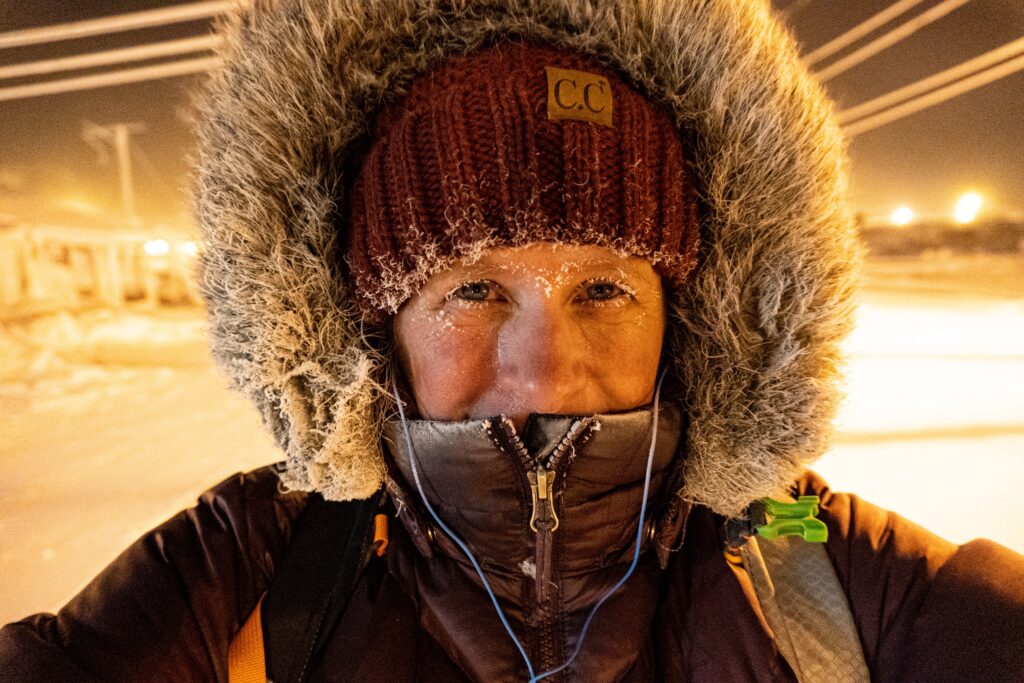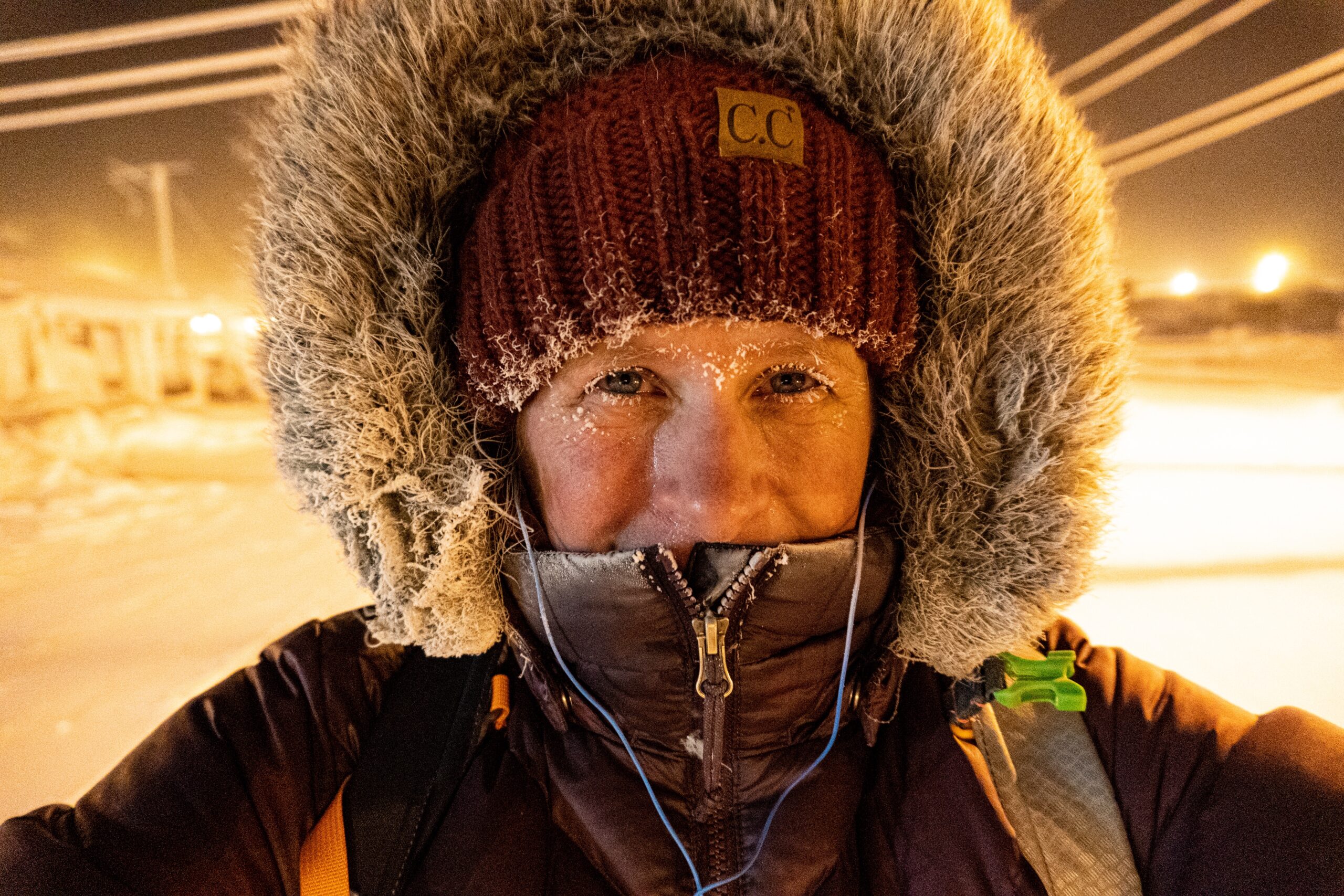By Kirsten

When it comes to the Arctic, dressing right isn’t just about comfort, it’s about survival. Our friends, the Inupiaq, have been masters of Arctic attire for generations, crafting ingenious clothing like animal skin parkas to brave the cold. Today, we’re fortunate to have modern materials offering even better insulation and functionality. So let’s honor their wisdom and embrace innovation as we explore the types of clothing suggested per season for anyone interested in going on an Arctic adventure!
Fall:
Clothing: Layering is key for fall in the Arctic. Bring long-sleeved shirts, sweaters or fleece jackets, and a waterproof, windproof outer layer. Pack warm pants, preferably waterproof or water-resistant, and thermal underwear for added insulation. Don’t forget to bring woolen socks, gloves, and a knit hat to keep extremities warm.
Footwear: Sturdy waterproof boots with good traction are essential for navigating wet terrain. Ensure they are insulated for warmth.
Gear: Consider bringing a lightweight, compact rain jacket or poncho, as fall in the Arctic can be rainy. Additionally, pack a backpack to carry essentials during outings and hikes.
Winter:
Clothing: Dressing warmly is crucial in Arctic winters. Bring heavy-duty insulated parkas or winter jackets, along with thermal base layers and fleece-lined clothing. Insulated snow pants or bibs are essential to keep legs warm. Pack multiple layers of socks, gloves, and mittens, as well as a balaclava or face mask for added protection against cold winds.
Footwear: Insulated, waterproof boots rated for extreme cold are necessary. Consider boots with removable liners for added versatility.
Gear: Don’t forget to pack hand and foot warmers to combat extreme cold temperatures. Additionally, bring high-quality sunglasses to protect eyes from snow glare, and consider packing a headlamp for increased visibility during the short daylight hours.
Spring:
Clothing: Spring in the Arctic can be unpredictable, with fluctuating temperatures and variable weather conditions. Bring a mix of lightweight and insulated layers, including long-sleeved shirts, sweaters, and a waterproof jacket or shell. Pack versatile pants that can be layered with thermal underwear if needed.
Footwear: Waterproof boots are still essential in spring, as melting snow and ice can create wet conditions. Ensure boots are insulated for warmth but also breathable to prevent overheating.
Gear: Pack waterproof gear covers or dry bags to protect electronics and other valuables from moisture during outdoor activities. Consider bringing insect repellent, as mosquitoes and other insects may become more prevalent in the spring months.
Summer:
Clothing: Summers in the Arctic can be surprisingly mild, but temperatures can still vary widely. Bring lightweight, breathable clothing such as long-sleeved shirts, lightweight pants, and shorts. Pack a waterproof, windproof jacket or shell for unexpected rain showers or chilly evenings.
Footwear: Sturdy hiking boots or trail shoes are recommended for summer activities, along with water-resistant sandals or water shoes for excursions near water bodies or on wet terrain.
Gear: Don’t forget to pack sunscreen with high SPF to protect against the intense summer sun, as well as a wide-brimmed hat and sunglasses. Bring a lightweight backpack for day trips and hikes, and consider packing a compact, portable insect repellent for protection against mosquitoes and other biting insects.
Regardless of the season, it’s important for educators to dress in layers, stay hydrated, and be prepared for changing weather conditions during their Arctic adventure.
If you are interested in joining us on a trip to the Arctic, please visit www.odysseydiscovery.com (travel).
Lesson Plan: Exploring Arctic Clothing with Authentic Connections
Objective: Students will explore the clothing worn by people living in the Arctic region, understand its significance, and make authentic connections to the Arctic culture and environment.
Grade Levels: Elementary, Middle School, High School
Materials Needed:
- Pictures or samples of traditional Arctic clothing (parkas, mittens, boots, etc.)
- Pictures or samples of clothing worn in students’ communities
- Internet access for research (optional)
- Poster paper and markers for group presentations (optional)
- Guest speaker or video resources featuring individuals from Arctic communities (optional)
Lesson Outline:
Introduction (10 minutes):
- Begin by engaging students with a question: “Imagine living in a place where the temperature drops below freezing for most of the year. How would you stay warm?”
- Discuss with students the challenges of living in the Arctic region, including extreme cold temperatures and harsh weather conditions.
- Introduce the concept of authentic connections by explaining that students will have the opportunity to learn about Arctic clothing and compare it to clothing worn in their own communities while also making meaningful connections to Arctic culture and lifestyle.
- Share any personal anecdotes or experiences related to the Arctic, if applicable, to pique students’ interest and provide context for the lesson.
Exploration (20 minutes):
- Show students pictures or samples of traditional Arctic clothing, such as parkas made from animal skins, mittens made from fur, insulated boots, and hats with ear flaps. Describe the materials used and the features of each item.
- Discuss the importance of layering in Arctic clothing to trap heat and keep the body warm, as well as the use of natural materials like fur and skins for insulation.
- Emphasize the cultural significance of Arctic clothing and how it reflects the lifestyle and traditions of indigenous communities living in the region.
- Encourage students to ask questions and express any observations or thoughts they have about the clothing.
Authentic Connection Activity (20 minutes):
- Invite a guest speaker from an Arctic community or show a video featuring individuals from Arctic communities discussing their clothing, lifestyle, and cultural traditions.
- Alternatively, if a guest speaker or video resource is not available, facilitate a virtual or written exchange with students from Arctic communities through email, social media, or pen pal programs to learn about their experiences and perspectives on clothing and life in the Arctic.
- Encourage students to ask thoughtful questions and engage in respectful dialogue to deepen their understanding and forge authentic connections with individuals from Arctic communities.
Comparison Activity (15 minutes):
- Divide students into small groups based on grade level.
- Provide each group with pictures or samples of clothing worn in their own communities, such as T-shirts, jeans, sneakers, and jackets.
- Instruct students to compare the Arctic clothing they learned about and the insights gained from the authentic connection activity with the clothing worn in their communities. Encourage them to discuss similarities, differences, and reasons for these variations, considering factors like climate, cultural traditions, and available resources.
- Each group will create a poster or presentation summarizing their findings to share with the class.
Reflection and Discussion (15 minutes):
- Lead a class discussion on the authentic connections students made to the Arctic culture and environment through the lesson.
- Ask students to reflect on what they learned from the guest speaker, video resource, or virtual exchange and how it deepened their understanding of Arctic clothing and lifestyle.
- Discuss the importance of empathy, respect, and cultural sensitivity when learning about and engaging with individuals from different backgrounds and communities.
Extension Activities (Optional):
- Research Project: Assign students to further research specific aspects of Arctic culture, such as traditional crafts, food, or music, and present their findings to the class.
- Creative Expression: Have students create artwork, poems, or stories inspired by their authentic connections to the Arctic, incorporating elements of Arctic clothing and culture.
- Community Outreach: Encourage students to share their learning and experiences with their families, friends, or local community through presentations, exhibitions, or blog posts.
Conclusion (5 minutes):
- Summarize the key points of the lesson, emphasizing the importance of making authentic connections to the Arctic culture and environment.
- Encourage students to continue exploring and learning about different cultures and perspectives, seeking opportunities to engage authentically with individuals from diverse backgrounds and communities.
Assessment: Assessment can be conducted through class participation, group presentations, and reflective activities. Evaluate students’ understanding of Arctic clothing, their ability to make authentic connections to Arctic culture and lifestyle, and their engagement with individuals from Arctic communities in a respectful and empathetic manner.

+ show Comments
- Hide Comments
add a comment